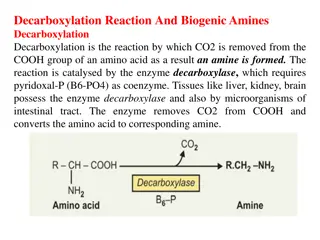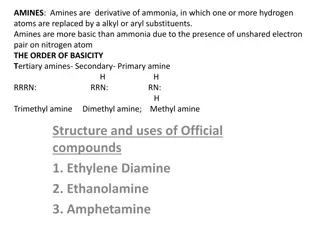Basic Character of Amines and Comparing Strengths
Amines are ammonia derivatives with varying basic strengths based on lone pair presence and stability of conjugate acid. Factors like steric hindrance and electron effects influence basic nature. Learn about comparing NH3, alkyl amines, and aromatic amines. Understand the impact of alkyl groups on electron density and stability in gaseous and aqueous phases. Explore the order of basic nature in different amine types.
Download Presentation

Please find below an Image/Link to download the presentation.
The content on the website is provided AS IS for your information and personal use only. It may not be sold, licensed, or shared on other websites without obtaining consent from the author.If you encounter any issues during the download, it is possible that the publisher has removed the file from their server.
You are allowed to download the files provided on this website for personal or commercial use, subject to the condition that they are used lawfully. All files are the property of their respective owners.
The content on the website is provided AS IS for your information and personal use only. It may not be sold, licensed, or shared on other websites without obtaining consent from the author.
E N D
Presentation Transcript
CHEMISTRY LESSON: CHEMISTRY LESSON: BASIC CHARACTER OF AMINES BASIC CHARACTER OF AMINES 1
objectives: Fundamental concepts on basic character of amines. Applications of these concepts in comparing the relative basic strengths of NH3, various alkyl amines, C6H5NH2 and other substituted aromatic amines. 2
FUNDAMENTAL CONCEPTS ON BASIC CHARACTER OF AMINES Amines are derivatives of ammonia: NH3 R NH2 +R -H Various types of amines are primary (10), secondary (20) and tertiary (30): RNH2 R2NH R3N (10) (20) (30) The basic nature of an amine is due to the presence of a lone pair on N, and its ability to donate it; and depends on the stability of the conjugate acid. 3
Steric hindrance plays an important role in deciding basic strength. Electron releasing groups increase the basic strength , whereas electron withdrawing group decrease the basic strength of amines. A higher value of pKb implies lower basic strength. 4
APPLICATION : COMPARISON OF NH3 AND RNH2 As the alkyl group has +I effect, it increases the electron density on N. Substituted ammonium ion is more stable due to charge dispersal by the alkyl group. So, RNH2 is more basic than NH3. 5
APPLICATION : COMPARISON OF RNH2, R2NH AND R3N IN GASEOUS STATE As the alkyl groups have +I effect, it increases the electron density on N. As these are in the gaseous phase, so only the +I effect is considered. So, the order of basic nature is: 30 > 20 > 10 > NH3. 6
APPLICATION : COMPARISON OF RNH2, R2NH AND R3N IN AQUEOUS STATE In aqueous solutions, in addition to +I effect, the solvation effect and steric hindrance are also at work. As 30 amines are least solvated, so their conjugate acids are least stable. So, we expect an order as : 10 > 20 > 30. But, due to the combination of +I and solvation effects, secondary amines become most basic. So, the order of basic nature in methyl substituted amines is: 20 > 10 > 30 > NH3. 7
But, this order applies to methyl substituted amines only. If R is ethyl (C2H5 ) group, then due to steric hindrance, solvation effect decreases in all the three types of amines. Hence, +I effect of tertiary amines tends to dominate over the solvation effect of primary amines. Hence, the order of basic nature in ethyl substituted amines is: 20 > 30 > 10 > NH3. Similarly, in propyl substituted amines, though electron density is increased due to +I effect, still, due to steric hindrance, ability to donate the electron pair is decreased and hence the order is changed again. The order of basic nature in propyl substituted amines is: 10 > NH3 >20 > 30. Similarly, the order of basic nature in butyl substituted amines is: NH3 > 10 > 20 > 30. 8
APPLICATION : COMPARISON OF AROMATIC AMINES WITH ALIPHATIC AMINES pKb of aniline is very high, as compared to that of alkyl amines; i.e., aniline is much less basic than alkyl amines. It is because the lone pair on nitrogen in aniline is in conjugation with the benzene ring. Also, anilinium ion (conjugate acid) is less stable than aniline as it has lesser number of resonating structures. 9
Presence of electron withdrawing group in the benzene ring decreases the basic strength and the presence of electron releasing groups increases the basic strength. NH3 NH3 is less basic than NO2 CH3 Electron releasing group Electron withdrawing group 10
THE ORTHO EFFECT IN AROMATIC AMINES It has been observed that any group; whether electron withdrawing, or electron releasing, at the ortho position in aniline always decreases its basic strength. This is known as the ORTHO EFFECT ORTHO EFFECT. The reason for the occurence of the ortho effect is steric hindrance. 11
QUESTIONS FOR PRACTICE QUESTIONS FOR PRACTICE (CLASSROOM EXERCISE) (CLASSROOM EXERCISE) Predict the increasing order of basic strength in each of the following cases: NH CH3 C NH2 (I) CH3 CH2 NH2 (II) CH3 O CH3 CH NH2 (III) CH3 C NH2 (IV) Answer: IV < II < III < I 12
NH2 NH2 NH2 NH2 CH 3 CH CH 3 (I) (II) (III) (IV) 3 Answer: II < I < III < IV NH2 NH2 NH2 NH2 NO2 NO2 NO2 (I) (II) (III) (IV) Answer: II < IV < III < I 13























